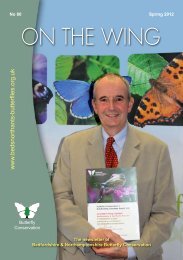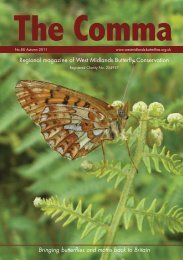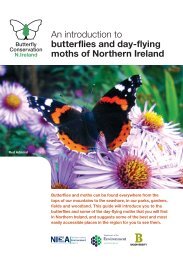EIG newsletter - Butterfly Conservation
EIG newsletter - Butterfly Conservation
EIG newsletter - Butterfly Conservation
You also want an ePaper? Increase the reach of your titles
YUMPU automatically turns print PDFs into web optimized ePapers that Google loves.
<strong>EIG</strong> Trip to Ecrins National Park, France<br />
to survey for Balkan Fritillary (Boloria graeca)<br />
10-17 July 2007.<br />
Balkan Fritillary (Boloria graeca) Photo: Tristan Lafranchis<br />
Following a successful trip to the Ecrins National<br />
Park last June when I invited friends who were<br />
interested in butterflies to join us we are returning<br />
in July 2007 to the same valley to undertake a<br />
survey for Balkan Fritillary (Boloria graeca) and<br />
will present our data, as before, to the National<br />
Park Authorities. We would like to ask members<br />
of <strong>EIG</strong> to join us. We had a good week in 2006<br />
with 93 species in all including such highlights as<br />
Poplar Admiral (Limenitis populi) and Alpine<br />
Grayling (Oenis glacialis).<br />
We stay in a campsite – Camping les Faures near Valjouffrey in a lovely valley that<br />
runs from La Mure, south of Grenoble east to a dead end in le Desert deep in the<br />
national park. The fact that the road doesn’t go anywhere means it is quiet and<br />
motorbikes are thankfully scarce. The campsite is cheap, simple but has a bar and<br />
evening pizzeria and last year had a fridge. Better still it is set in open country and<br />
many species can be found in or around the campsite including Apollos (Parnassos<br />
Apollo), Large Blue (Maculinea arion), Scarce (Lycaena virgaureae) and Purple<br />
Edged Copper (Lycaena hippothoe). Some of the fields are cut for hay in June.<br />
We take our campervan but camping is the easiest<br />
alternative though there is some accommodation in the<br />
valley, which friends used last year. This year I have<br />
booked in for 10-17 th July and I have said I will tell them if<br />
we are more than 20 people so you will need to let me<br />
know if you are coming. You will need your own<br />
transport and despite the pizzeria you need to be able<br />
provide your own meals. You don’t need to come for the<br />
whole week. Last year I arranged beforehand for several<br />
of us to get permits to use nets in the National Park,<br />
which is almost essential for identifying Pyrgus & Mellicta<br />
species. Working as a group it is easier to learn and gain confidence over<br />
identifying difficult species but it does help if you can get a consensus view. You also<br />
see more. Contact me if you need a permit and give me the dates you will be there.<br />
We will be looking specifically for Balkan Fritillary Boloria graeca, which has been<br />
recorded in the national park but not very often. It is found in the western Alps as<br />
well as the Balkans. It is a scarce Red Data Book species that occurs at high altitude<br />
(1200-2600m) so we will be doing a lot of walking. Where possible we will walk in<br />
small groups on well marked tracks and attempt to leave a car at the destination<br />
point. Mountain walking kit including emergency equipment is strongly<br />
recommended for the high altitude walks but is not essential in the campsite area<br />
itself. It is a condition of participation in the trip that people have their own travel<br />
insurance. Personal accident and public liability will be covered by BC insurance. If<br />
people don't fancy driving all the way it is possible to fly to Grenoble, Lyon or Geneva<br />
and pick up a hire car.<br />
Simon and Anne Spencer: Email cerisyi@btinternet.com - Telephone 01691 648339<br />
6<br />
View from Campsite, Valjouffrey Photo: Anne Spencer







